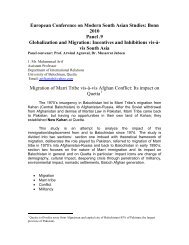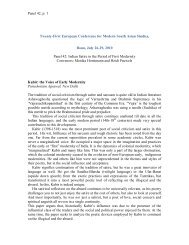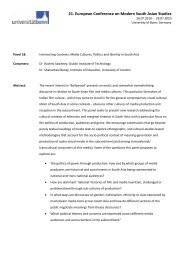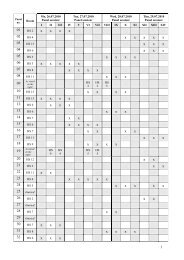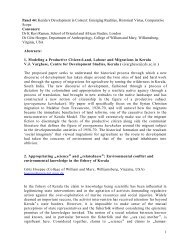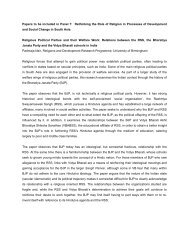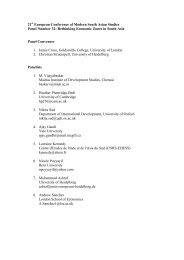European Conference on Modern South Asian Studies 2010
European Conference on Modern South Asian Studies 2010
European Conference on Modern South Asian Studies 2010
You also want an ePaper? Increase the reach of your titles
YUMPU automatically turns print PDFs into web optimized ePapers that Google loves.
epresented in nati<strong>on</strong>alist and progressive Marxist literature.<br />
Rebellious natures in Hindi writing<br />
Thomas de Bruijn<br />
The esthetics of the literary representati<strong>on</strong> of individuals that are in some way or other<br />
disc<strong>on</strong>nected from the mainstream of society has received much attenti<strong>on</strong> in studies <strong>on</strong><br />
modernist writing, especially the stories from the post-Independence Nayi Kahani<br />
movement. It has often been noticed that there is a link in this representati<strong>on</strong> between<br />
the cultural and religious complex of renunciati<strong>on</strong> and asceticism and the depicti<strong>on</strong> of<br />
alienated individuals who struggle to find a way in modern society. The dominant positi<strong>on</strong><br />
of Nayi Kahani in Hindi writing has led to a str<strong>on</strong>g imprint of this esthetic and thematic<br />
program <strong>on</strong> more recent literature.<br />
The rise of Dalit writers has added a new semantic strain to the representati<strong>on</strong> of<br />
individuals. In this writing, alienati<strong>on</strong> is not the main emoti<strong>on</strong>al t<strong>on</strong>e, but rather the<br />
account of sharp exclusi<strong>on</strong> and struggle for survival and dignity in a harsh and forbidding<br />
society. Rebelli<strong>on</strong> and inner c<strong>on</strong>victi<strong>on</strong> are the main characteristics of the individuals in<br />
Dalit writing.<br />
The present paper will explore the c<strong>on</strong>trast between the two semantic and esthetic<br />
programs for the representati<strong>on</strong> of the rebelli<strong>on</strong> of a protag<strong>on</strong>ist. It will try to dem<strong>on</strong>strate<br />
how Nayi Kahani and Dalit writing, coming from opposite directi<strong>on</strong>s, meet in using<br />
references the discourse of renunciati<strong>on</strong> to depict the individualisati<strong>on</strong> of their<br />
protag<strong>on</strong>ists. The cultural and thematic coordinates of their references to this shared<br />
cultural paradigm are completely different. With reference to Dalit stories collected in the<br />
volume Carcit Dalita Kahaniyam, edited by Dr. Kusum ‘Viyogi’ (Delhi: Lalit Prakshan, 1997)<br />
it will attempt to positi<strong>on</strong> this representati<strong>on</strong> of rebelli<strong>on</strong> <strong>on</strong> the map of Hindi writing.<br />
Unknowable or Comprehensible -Two Attitudes to Life and Death<br />
In <strong>Modern</strong> Hindi prose<br />
Guzel Strelkova<br />
The paper is mainly based <strong>on</strong> the novels by Ajneya “Apne –apne ajnAbi” (To each his<br />
stranger), 1961, and Krishna Sobti “ Ai, LaRkI” (Hey, Girl!), 1991.<br />
From the very beginning of his literary career the main hero of Ajneya’s prose was a<br />
pers<strong>on</strong> going <strong>on</strong> the path of “Resistance and rebelli<strong>on</strong>” and experiencing a feeling of<br />
exclusi<strong>on</strong> from the comm<strong>on</strong> world. Let it be his early stories (like “VipathagA” or “Vivek se<br />
baRhkar) or Shekhar – the hero of his first novel “Shekhar: ek jIvanI”, or heroes of his<br />
later creati<strong>on</strong>s. Some of Krishna Sobti’s heroines also could be c<strong>on</strong>sidered and understood<br />
as marginal (Mitro Marjani of the same name novel, Ratti of “SUrajmukhI andhere ke” or<br />
Mahak Banu of “Dilo-Danish”), but they try to overcome this marginality and sometimes<br />
reach their aim by rebel, at least a clear, open protest. Heroes of the both writers express<br />
their rebellious or marginal nature in different ways, reas<strong>on</strong>s for their rebelliousness and<br />
marginality are also different.<br />
One of the aims of my paper is to present this rebellious nature of the heroes and how it<br />
changes or not under the force of circumstances and oppositi<strong>on</strong> to the society.<br />
In my paper I proceed from the assumpti<strong>on</strong> that creati<strong>on</strong>s of the both writers combine a<br />
western and Indian approach to understanding and representing the world. The novels<br />
look very close in compositi<strong>on</strong>, choosing the main heroes and highlighting key points. In<br />
my paper I try to show that Ajneya and Krishna Sobti in these novels reached practically<br />
opposite results presenting their heroes <strong>on</strong> the margin between Life and Death, the heroes



